
Volodymyr, previously known as Volodymyr-Volynskyi (Володимир-Волинський) from 1944 to 2021, is a small city in Volyn Oblast, northwestern Ukraine. It serves as the administrative centre of Volodymyr Raion and the center of Volodymyr urban hromada. It is one of the oldest cities in Ukraine and the historic centre of the region of Volhynia; it served as the capital of the Principality of Volhynia and later as one of the capital cities of the Kingdom of Galicia–Volhynia. Population: 37,910.

Lychakiv Cemetery, officially State History and Culture Museum-Preserve "Lychakiv Cemetery", is a historic cemetery in Lviv, Ukraine.
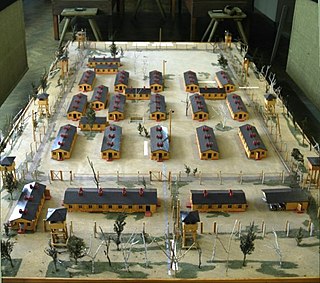
In Germany, stalag was a term used for prisoner-of-war camps. Stalag is a contraction of "Stammlager", itself short for Kriegsgefangenen-Mannschaftsstammlager, literally "main camp for enlisted prisoners of war". Therefore, "stalag" technically means "main camp".
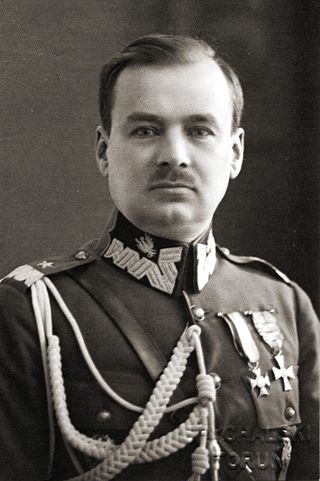
Wiktor Thommée (1881–1962) was a Polish military commander and a brigadier general of the Polish Army. A veteran of the Great War and the Russian Civil War, he is best known for his command over Piotrków Operational Group and the battle of the Bzura during the Invasion of Poland of 1939.

Stalag IV-B was one of the largest prisoner-of-war camps in Germany during World War II. Stalag is an abbreviation of the German Stammlager. It was located 8 km (5.0 mi) north-east of the town of Mühlberg in the Prussian Province of Saxony, just east of the Elbe river and about 30 mi (48 km) north of Dresden. From 1944 to 1945 it belonged to the Province of Halle-Merseburg. Now, the area is in Brandenburg. A sub-camp, sometimes identified as Stalag IV-B/Z,Stalag 304 or Stalag IV-H was located at Zeithain, 10 km (6.2 mi) to the south in Saxony.

Stalag VII-A was the largest prisoner-of-war camp in Nazi Germany during World War II, located just north of the town of Moosburg in southern Bavaria. The camp covered an area of 35 hectares. It served also as a transit camp through which prisoners, including officers, were processed on their way to other camps. At some time during the war, prisoners from every nation fighting against Germany passed through it. At the time of its liberation on 29 April 1945, there were 76,248 prisoners in the main camp and 40,000 or more in Arbeitskommando working in factories, repairing railroads or on farms.
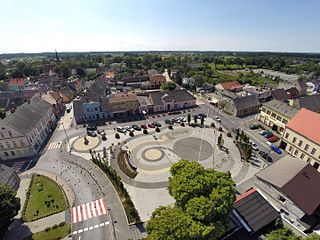
Szubin is a town in Nakło County, Kuyavian-Pomeranian Voivodeship, Poland, located southwest of Bydgoszcz. It has a population of around 9,333. It is located on the Gąsawka River in the ethnocultural region of Pałuki.
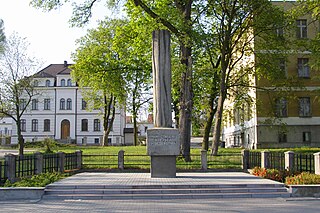
Oflag XXI-B and Stalag XXI-B were World War II German prisoner-of-war camps for officers and enlisted men, located at Szubin a few miles southwest of Bydgoszcz, Poland, which at that time was occupied by Nazi Germany.

Zeithain is a municipality in the district of Meißen, in Saxony, Germany.

The Ukrainian War of Independence, also referred to as the Ukrainian–Soviet War in Ukraine, lasted from March 1917 to November 1921 and was part of the wider Russian Civil War. It saw the establishment and development of an independent Ukrainian republic, most of which was absorbed into the Ukrainian Soviet Socialist Republic between 1919 and 1920. The Ukrainian Soviet Socialist Republic was one of the constituent republics of the Soviet Union between 1922 and 1991.

Przysposobienie Wojskowe Kobiet was a Polish organization for women, which existed in the interbellum period as well as during World War II. This was not a paramilitary organisation.

The Ukrainian People's Army, also known as the Ukrainian National Army (UNA) or by the derogatory term Petliurivtsi, was the army of the Ukrainian People's Republic (1917–1921). They were often quickly reorganized units of the former Imperial Russian Army and newly formed volunteer detachments that later joined the national armed forces. The army lacked a certain degree of uniformity, adequate leadership to keep discipline and morale. Unlike the Ukrainian Galician Army, the Ukrainian People's Army did not manage to evolve a solid organizational structure, and consisted mostly of volunteer units, not regulars.

Pikulice is a village in the administrative district of Gmina Przemyśl, within Przemyśl County, Subcarpathian Voivodeship, in south-eastern Poland, close to the border with Ukraine. It lies approximately 4 kilometres (2 mi) south of Przemyśl and 65 km (40 mi) south-east of the regional capital Rzeszów.

Powązki Military Cemetery is an old military cemetery located in the Żoliborz district, western part of Warsaw, Poland. The cemetery is often confused with the older Powązki Cemetery, known colloquially as "Old Powązki". The Old Powązki cemetery is located to the south-east of the military cemetery.

"Italian Military Internees" was the official name given by Germany to the Italian soldiers captured, rounded up and deported in the territories of Nazi Germany and German-occupied Europe in Operation Achse in the days immediately following the World War II armistice between Italy and Allied armed forces.
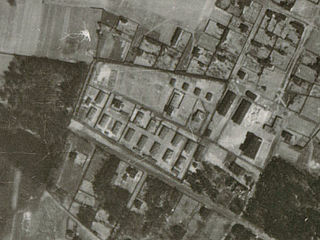
Stalag Luft II was a Luftwaffe-run prisoner-of-war (POW) camp during World War II, in Łódź, in the occupied territory of Poland.

Nazi Germany operated around 1,000 prisoner-of-war camps during World War II (1939-1945).
Vyalikiya Yodkavichy is a village in Byerastavitsa District, Grodno Region, in western Belarus. It is part of Eysmanty selsoviet.

The Roman Catholic parish cemetery in Suwałki is the cemetery serving the Roman Catholic community of Suwałki. The necropolis belongs to the Co-Cathedral Parish of St. Alexander and is located on Zarzecze Street in the western part of the city. It was established in 1820 and remains the largest cemetery in Suwałki.
Polish prisoners of war in World War II were soldiers of the Polish Armed Forces captured by Germany and the Soviet Union during and after their invasion of Poland in 1939. Following the defeat of Poland, tens of thousands of Polish soldiers were interned in camps, with many subjected to forced labor, harsh conditions, and political repression. While some prisoners were later released or escaped to join resistance movements, others suffered severe mistreatment or were executed, most notably during the Katyn massacre.



























